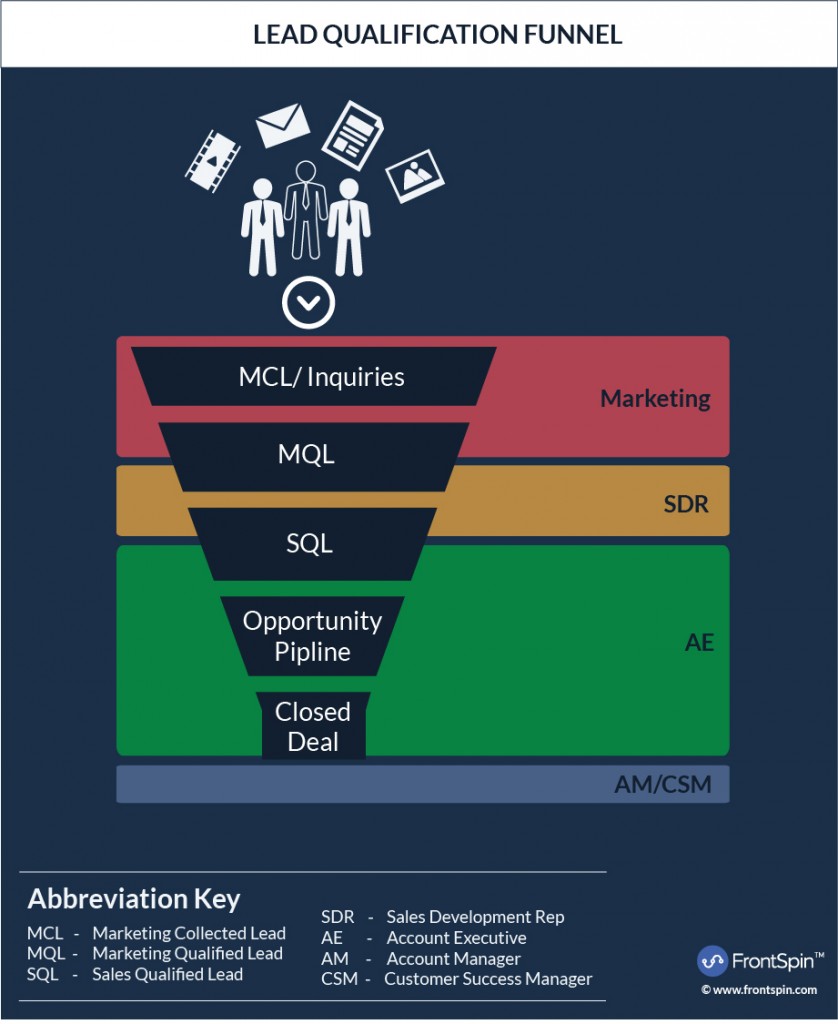I’ve started several startups and advised countless others. One thing, however, has remained constant: friction between sales and marketing.
Most of the times, this friction stems from an inability to define where marketing ends and sales begins. Sales is seldom satisfied with the quality and quantity of incoming leads, while marketing complains about sales doing little with the leads it already has. Do not think for a moment that this conflict is limited to startups. I’ve served on the boards of large companies where VPs of Marketing and the VPs of Sales have literally fought over the quality of leads.
The first step in reducing the friction between sales and marketing is to come to a clear definition of a Sales Qualified Lead (SQL), since this is where the hand-off from marketing to sales takes place.
In this post, I’ll help you understand what makes an SQL and put a figure to the percentage of SQLs a well-performing sales team should be closing.
Essential Definitions
Before we start, a few quick definitions, just to make sure that we are all on the same page:
1. MCLs or Marketing Collected Leads
An incoming inquiry collected through marketing. This is a raw lead and needs further qualification before it can be passed further down the funnel (only 4% of marketing-generated leads actually close, according to 47% of B2B marketers).
2. MQLs or Marketing Qualified Leads
An MCL that meets certain standards (such as intent or action) is classified as an MQL. An MQL falls in the ‘second stage’ of the lead qualification process and is more likely to convert to a sale than other inquiries. Once a lead is classified as an MQL, it is ready to be handed over to a human such as an SDR (Sales Development Representative).
3. SQLs or Sales Qualified Leads
The SDR qualifies MQLs based on set criteria (budget, need, authority, etc. – more on this below). Leads that meet these standards are classified as SQLs and are ready to be handed over to an Account Executive (AE).
Some sales organizations use an interim stage between MQL and SQL called ‘SAL’ or Sales Accepted Lead. SAL is a way for AEs to quality check incoming leads and ensure only the most relevant make it to SQL status. More often than not, SALs are grouped under SQL.
4. Opportunities
SQLs that have become real sales opportunities are classified as ‘opportunities’. These are leads that are ready to close, set-up a meeting with, etc.
The Lead Qualification Process in a Nutshell
The lead qualification process follows a waterfall model where a prospect enters the top of the funnel as an MCL and exits as a customer (or at least, as an opportunity). At each stage in the funnel, unqualified leads get filtered out, qualified leads are squeezed through.
Consider the following process as an example:
Stage I: A prospect lands on your website and fills out a form. This prospect is now an MCL.
Stage II: An automated lead intelligence tool such as Eloqua or Marketo analyzes this lead and classifies it as an MQL.
Stage III: A SDR takes over and analyzes if this lead is ready to be sold to. If yes, it is qualified as an SQL. Else, it goes back to marketing for nurturing.
Stage IV: Once a lead is classified as an SQL, AEs take over, typically turning the SQL to an opportunity and moving it through the pipeline.
The actual handover from marketing to sales takes place in Stage III. This, as you might imagine, is a big source of conflict in most companies. Much of this stems from a simple question: what really makes an SQL?
The answer? It depends.
What Makes an SQL?
Although the term ‘SQL’ is used widely across industries, it can mean very different things to different organizations.
For example, at a Fortune 500 company I was once a part of, sales always complained that there were “not enough leads”. As a response, marketing started passing off underqualified MQLs to SQLs to account executives. Suddenly, sales had all the leads it wanted, but conversion rates were abysmal. These leads were still ‘SQLs’, but only because marketing relaxed the qualification criteria. The actual lead quality remained unchanged (and hence the drop in conversion rates).
Traditionally, you would classify a MQL as an SQL if it met the BANT criteria:
Budget – Does the lead have the budget to purchase our solution?
Authority – Does the lead have the authority to sign-off on a new deal?
Need – Does the lead need our solution to meet a business challenge?
Timeframe – Do we know when the lead will need our solution?
As you can imagine, getting all this information about a lead is hard. Even if you do manage to get all this data, only 5% of leads are actually in the buying process. Sticking strictly to BANT will often cause your AEs to sit idle, waiting for leads to come through the pipeline.
In such scenarios where your AEs are not operating at full capacity, you might choose to define SQLs with the AN criteria:
Authority – Does the lead have the authority to sign-off on the deal?
Need – Does the lead need our solution?
By removing the requirement for budget and timeframe, your AEs will see more leads at the top of the funnel. However, since you’ve relaxed the qualification criteria, your SQL to Opportunity conversion rate will go down as well. This creates also more work for your AE as they have to manager more leads that are less qualified (though you can mitigate this somewhat by using automated tools like power dialers to reach out to more leads, even if they are not BANT).
As always, there is a trade-off between quality and quantity.
The definition of a SQL, thus, is not constant throughout the industry and the growth of a company. You might start off with an AN scheme when your team is small and lead volume is limited. As your sales team matures and you add more SDRs, you might switch to a BANT or ANUM (Authority, Need, Urgency, Money) to improve lead quality to AEs.
The important part is to constantly optimize the qualification criteria to make sure only the best leads get through to your hunters. At the same time, you must ensure that you have a full pipeline to keep your AEs busy.
To make this delicate balance possible, it is crucial that sales and marketing agree on a shared definition of SQL. Once you agree on a definition, you can work out the balance between quantity vs. quality.
Finally, to answer the original question: what percentage of SQLs should you close?
The short answer, in numbers based on my experience:
- If SQL is a BANT, you should be able to close between 25% and 35%
- If SQL is non BANT, close rates should be between 10% and 20%
The long answer, of course, is “it depends”.
For more insight on marketing stats to consider going into 2021, check out this article.
Mansour Salame
Latest posts by Mansour Salame (see all)
- The Failed Sales Plan - May 20, 2016
- What Percentage of Leads Should You Close? - April 14, 2015
- Anatomy of an Inside Sales Team: The 5 Key Parts - February 25, 2015



Hi, these #’s are great! Thanks for sharing. Do you have a figure for span in days to move from stage IV to close??